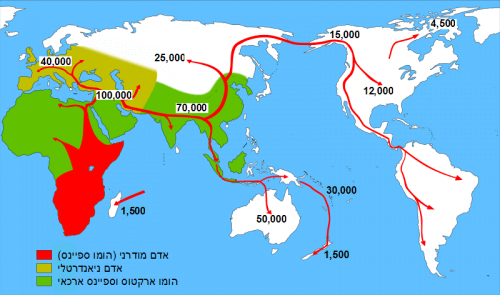Researchers from Ben-Gurion University of the Negev have shown for the first time that the ancient migration of man from Africa to settle the rest of the world left its signature as mutations of Carthian significance in the DNA inherited from the mother to her offspring, the mitochondrial DNA

Researchers from Ben-Gurion University of the Negev have shown for the first time that the ancient migration of man from Africa to settle the rest of the world left its signature as mutations of Carthian significance in the DNA inherited from the mother to her offspring, the mitochondrial DNA. While during the last 30 years many researchers treated the 37 genes in the mitochondrial DNA, in contrast to the ~25,000 in the genome in the cell nucleus, as records of the rate of change only, researchers from Ben-Gurion University have shown that ancient mutations in the mitochondrial DNA have a controlling effect on the activity of the mitochondria in a different way in Africans compared to non-African people.
Mitochondria, ancient bacteria-like organelles, are considered the main energy suppliers of the cell. The energy produced in the mitochondria allows us to think, hear, see and move. Mitochondrial mutations that occurred during ~150,000 years of modern human evolution changed the genetic material in the mitochondria and shaped the regulatory landscape of this organelle.
Prof. Dan Mishmer and students Tal Cohen and Liron Levin from his laboratory chose an unbiased approach to study gene expression (RNA-seq) in a large group of individuals (454) and discovered that the expression pattern of the genes encoded in the mitochondrial DNA is different between Africans and non-Africans (mainly Europeans) . As part of the researchers' analysis, a possible mechanism underlying the described differences was proposed, involving RNA-binding proteins. These findings were recently published in the journal PLoS Genetics.
For over three decades, mutations that define population variation in mitochondrial DNA were treated as neutral, and were therefore considered changes that accumulated over time without affecting activity. This thought led to the use of mitochondrial genetic variation as a marker for population migration during evolution. It seems that this approach should be re-evaluated in light of the findings of the study. Using tools that allow the detection of small changes in the mitochondrial DNA, it is possible for Prof. Mishmar and his laboratory team to detect their potential to influence activity.
"Our paper reveals strong evidence that genetic variation in mitochondrial DNA has a control value, and therefore these mutations are functional and not passive. This means that such mutations played an active role in the human migration from Africa to settle the rest of the world," Mishmar says.
"Since our findings change the approach to the role played by genetic variation in mitochondrial DNA during human evolution, the findings will attract the attention of population geneticists, biochemists, evolutionary researchers, archaeologists, anthropologists and even self-taught genealogists," he adds.
Prof. Mishmar heads the University Center for Genomic and Medical Evolution, and is a senior faculty member in the Department of Life Sciences, in the Faculty of Natural Sciences.
The research was funded by research grants from the Israel Science Foundation, the Binational Foundation and a fund from the Life Sciences Unit of the US Army.

2 תגובות
http://in.bgu.ac.il/en/Pages/news/ancient-mtDNA.aspx
http://journals.plos.org/plosgenetics/article?id=10.1371/journal.pgen.1006407
What about a reference to the original article?